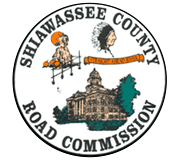This page includes SCRC’s policies, plans and procedures sorted by category. Many of the documents are downloadable PDFs which require a PDF viewer to read. If you do not have Adobe Acrobat Reader, a free download is available from the Adobe website. If you are searching for specific information in a policy, plan or procedure you can use the find comment (Control + F) to search the document.
The Township pays for the gravel as spread by private subcontractors as bid. The Road Commission pays for other costs, i.e. leveling, shaping and supervision of the project.
The Township pays for the crack filling and sealcoating as bid by private contractor. The Road Commission will take bids, administer the contract and provide inspection. The Road Commission pays for dura-patching prior to sealcoating, which may eliminate the need for crack filling.
The Township pays for dust control applied continuous one or two passes wide at an application rate as specified by the Township. Townships have the option of paying for a second application of dust control. The Road Commission will grade the roads prior to applying the chloride/brine and provide supervision of the application. Chloride/brine will be applied by private contractor.
The Township pays for the cost of the culverts for all culverts 36″ and larger. Large culverts and structures that can not be installed by the Road Commission will be installed by a private contractor with details and costs to be worked out between the Township and The Road Commission. The Road Commission pays for backfill material costs for culverts 36″ and larger. The Road Commission pays 100% of the costs for culverts smaller than 36″.
Costs for driveway culverts are the responsibility of the property owner.
The Township would be required to pay for driveway and cross culverts if required as a part of a road construction project.
The Road Commission pays 100% of the cost for roadside mowing.
Hard surfaced roads will be mowed twice per year.
Gravel surfaced roads will be mowed once per year with the intersections mowed twice per year.
The Road Commission pays for pavement markings unless included under a paving agreement with the Township.
Construction costs – Federal 80%, State 15%, and local match 5%.
The Road Commission pays the 5% local match plus Design, TSL study, Environmental Assessment, Historical Study and Construction Engineering.
The Townships are not required to participate in the cost of bridge construction unless a Township contribution is needed.
The Shiawassee County Road Commission entered into an agreement with the Michigan Department of Transportation in 1999 to exchange Shiawassee County’s Federal Aid Funds at a rate of $0.75 in State Funds for $1.00 in Federal Funds allocated to Shiawassee County. The exchange of funds program is no longer offered by MDOT.
Statewide economic development for targeted industries (agriculture, tourism, forestry, mining, high tech research, manufacturing and office centers larger than 50,000 sq. ft.)
State 80% and Road Commission, Township, Cities and Villages 20%.
State 80% and Road Commission, Township, Cities and Villages 20%.
The Michigan Vehicle Code, Public Act 300 of 1949, Section 257.615, prohibits the placement of any signs in the road right-of-way that may distract or obstruct the view of the public to see traffic enforcement signs; that blink or resemble traffic control devices; and/or that may create a hazard. The Michigan Vehicle Code further provides that the public authority having jurisdiction over the highway (a road commission), is empowered to remove, from the right-of-way, any such sign as a public nuisance.
A Rule of Thumb for County Primary and Local Roads…
When in doubt, the safest assumption is to place your signs behind sidewalks or utility poles, as these are typically located near the edge of the road right-of-way.
If no utility poles or sidewalks are present, then place your signs a minimum of 33 feet from the center of a two-lane road, and/or 60 feet from the center of a three or more lane road. This is typically considered to be a reasonably safe and adequate distance from the road, and legally out of right-of-way areas.
Signs that are placed within the right-of-way on the Shiawassee County Primary and Local Road systems, which are under the direct jurisdiction and authority of the Shiawssee County Board of Road Commissioners, are subject to removal by the Shiawassee County Road Commission, without notice, as provided by MCL 257.615. The removed signs shall be disposed of immediately by the Shiawassee County Road Commission.
Click here for more information on the county Sign Removal Policy.
On State Highways…
For safety, temporary signs must conform to state regulations for placement.
Signs are not allowed within clear vision areas at intersections or commercial driveways.
Signs must be placed more than 30 feet from the edge of the roadway (or from the white line along the edge) on highways without barrier-type curbs.
On highways with barrier curbs, signs must be more than 3 feet from the back of the curb.
Signs that do not meet these criteria are subject to removal by the Shiawassee County Road Commission, without notice, as provided by MCL 257.615. Sign owners can pick up any removed signs at the Shiawassee County Road Commission. Signs not claimed within seven days of their removal will be discarded.
For more information on MDOT political sign placement standards, visit the MDOT website at:
www.michigan.gov/mdot
